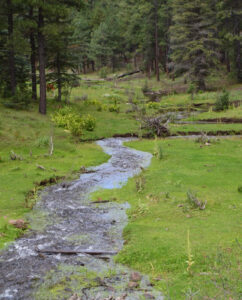The Upper East Verde River, which in reality is the size of a small creek, is a beautiful place to fish. It is home to a remnant population of wild rainbow trout from stocking efforts several decades ago, when a hatchery utilized the springs that feed this stream. While the hatchery is long-gone, the trout remain and are fun to catch. The Upper East Verde is just below the Mogollon Rim about 30 minutes from Payson, AZ.
Occasionally trout will approach 10 inches, but most of the fission this catch-and-release stream range between four to six inches. These wily trout seek the cover of rock ledges, boulders and downed wood in the creek. Unfortunately, there are sections of the Upper East Verde that have eroded down to shallow bedrock shelves that provide no cover for trout, nor good habitat for aquatic insect life.
Recently, three Arizona TU chapters helped improve one of these sections. The work was planned and supervised by the Arizona Game and Fish Department, U.S. Forest Service, and Natural Channel Design, Inc. Members from Gila Trout, Zane Grey and Old Pueblo Chapters participated in the project
with members of the Mogollon Sporting Association. The approximately 200 foot section of stream was transformed from a shallow, barren rock shelf to three wonderful pools and an enhanced upper fourth pool thanks to the construction of four log chevrons and the efforts of about 20 folks focused on making the stream better for wild rainbow trout.
Several logs were cut on site prior to the work day and then fitted to size as the project unfolded. The logs were secured to the bedrock with brackets and cabling in upstream-facing chevron patterns and wedged into the rock ledges and banks on the downstream ends. Once the improvements were in place, wheelbarrows full of large cobble were wedged into the gaps between the logs and the stream bed. Leaf and wood debris were then piled in the gaps in front of the logs and more cobble added to create pools of a foot or more; where hours before, the stream was merely a two- or- three-inch trickle over bedrock.
These chevrons will catch sediment, gravel and cobble in the years to come, and restore this section of the stream to more natural and productive conditions that will be great for trout.
AZTU looks forward to upcoming projects planned for two additional streams in the same area that will benefit from similar stream improvement work. As soon as funds are secured, TU will have plenty of volunteers to help make these streams better for trout.
Jim Strogen
Trout Magazine


